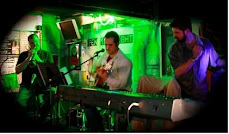

Not only is Thursday an odd day for jam sessions, but jammin' with a horn section is really odd nowdays. And if I had a photo of Kyle on alto sax or Steve on flute, I'd post them, too. But as it is, here's what I've got: On the left (bari sax) is Eli who drives all the way in from Girdwood. Mike (center) on tenor...he owns the place. That's why I always make sure his solos are better than mine. That's me on the right...I'm up to bat. Matt Hammer runs the jam (thats him in the sidebar...the back of his nw CD. In total, a dozen or so musicians shake the timbers on jam night. Soooooo, if you're ever in the area (Eagle River, Alaska), stop by for some rock, jazz, blues, and country.
Listening to Rock n Roll reminds me of what PhD Morris Massey said about the ‘60s advertising promotion of the Ford Mustang: “Mustang makes it happen.” Everybody went out and bought Mustangs, then sat around and waited for something to happen. Nothing did. I’ve always liked Rock n Roll but the drive and tone leads people to think that something exciting is about to happen. People bounce around for 3 minutes, getting excited, at the end of the song, they stop and look around. But nothing’s happened. It’s musical accompaniment to inconsequential movement. That’s fine with me, but I think it’s funny.Now, jazz, although early on was based on the tempo and rhythm, later became food for the connoisseur of tones, chords and spontaneous creativity. Phil Gleason said watching a jazz musician improvise is like watching a poet compose a poem right in front of a crowd. Whatever he creates on the spot, he delivers with no chance of revising it. What you hear is what he invented the second you heard it, with no chance to correct mistakes. The entertainment of jazz is in watching the craftsman create and deliver the variations of phrasings.
In the late 60’s it became synonymous with the intellectual – mystical in it’s depth…peeing into the soul. Well over-dramatized. But many art forms, accredited with deep introspection created awe in spectators. Authors from Tennessee Williams to Jack Kaorak donned facial expressions and postures of world-weary wisdom. Well, why not? I feel nostalgic thinking back on those days. Hemingway was an icon, the act of writing was revered, peering into the soul of man now days is clinical and cynical. Miles Davis and John Coltrane were Ayatollahs of a music form that kept people spell-bound. Listeners hung on every note. Two or four bar phrasings were composed like lines of poetry. The tone, texture, volume, and attitude of the musician were like reading the lines aloud. The music itself spawned poetry and painting. Album covers like Mancini’s “Peter Gunn”, or a Getz/Bryd album sported paintings.
The works of composers that have survived for four hundred years, the classical works, have been studied and performed all these centuries are listened to with reverence. But listening to one pianist playing a Beethoven piece, is not much different than listening to another pianist playing the same piece. It has occurred to me that it is the mastery of finger dexterity rather than creativity: Mechanical repetition leading to duplication. On the other hand, the Modern Jazz Quartet, played Bach in an entirely unique way. With a classical orchestra they played it through completely. Then the orchestra backed away while the MJQ improvised spontaneously, meticulously running riffs over the chord changes until it was time for the orchestra to join in again to play it as written again. One jazz pianist was caught playing classical pieces one afternoon in the night club he’d been performing at. He said he did it to practice. I have a CD with jazz flutist Hubert Laws playing Beethoven’s Moonlight Sonata. Not so rare. Now hearing a classical musician play jazz, well, that would be an oddity.


No comments:
Post a Comment